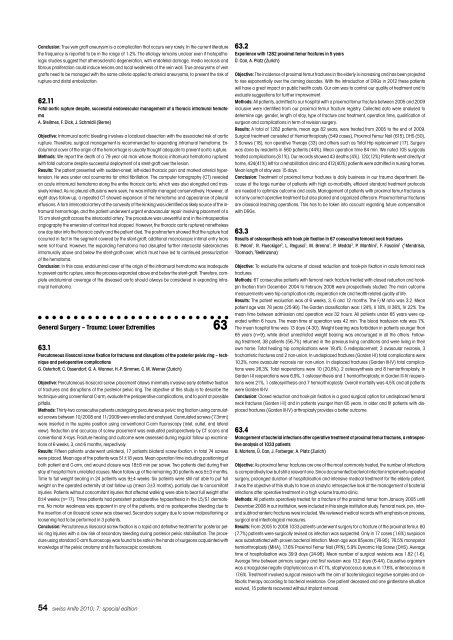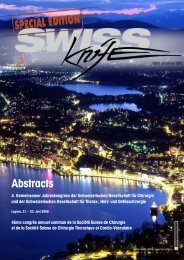Anorectal Manometry in 3D NEW! - Swiss-knife.org
Anorectal Manometry in 3D NEW! - Swiss-knife.org
Anorectal Manometry in 3D NEW! - Swiss-knife.org
You also want an ePaper? Increase the reach of your titles
YUMPU automatically turns print PDFs into web optimized ePapers that Google loves.
Conclusion: True ve<strong>in</strong> graft aneurysm is a complication that occurs very rarely. In the current literature<br />
the frequency is reported to be <strong>in</strong> the range of 1-2%. The etiology rema<strong>in</strong>s unclear even if histopathologic<br />
studies suggest that atherosclerotic degeneration, with endotelial damage, media necrosis and<br />
fibrous proliferation could <strong>in</strong>duce lesions and local weakness of the ve<strong>in</strong> wall. True aneurysms of ve<strong>in</strong><br />
grafts need to be managed with the same criteria applied to arterial aneurysms, to prevent the risk of<br />
rupture and distal embolization.<br />
62.11<br />
Fatal aortic rupture despite, successful endovascular management of a thoracic <strong>in</strong>tramural hematoma<br />
A. Stellmes, F. Dick, J. Schmidli (Berne)<br />
Objective: Intramural aortic bleed<strong>in</strong>g <strong>in</strong>volves a localized dissection with the associated risk of aortic<br />
rupture. Therefore, surgical management is recommended for expand<strong>in</strong>g <strong>in</strong>tramural hematoma. Endolum<strong>in</strong>al<br />
cover of the orig<strong>in</strong> of the hemorrhage is usually thought adequate to prevent aortic rupture.<br />
Methods: We report the death of a 79 year old man whose thoracic <strong>in</strong>tramural hematoma ruptured<br />
with fatal outcome despite successful deployment of a stent-graft over the lesion.<br />
Results: The patient presented with sudden-onset, left-sided thoracic pa<strong>in</strong> and marked arterial hypertension.<br />
He was under oral coumar<strong>in</strong>s for atrial fibrillation. The computer tomography (CT) revealed<br />
an acute <strong>in</strong>tramural hematoma along the entire thoracic aorta, which was also elongated and massively<br />
k<strong>in</strong>ked. As no pleural effusions were seen, he was <strong>in</strong>itially managed conservatively. However, at<br />
eight days follow-up, a repeated CT showed expansion of the hematoma and appearance of pleural<br />
effusions. A torn <strong>in</strong>tercostal artery at the convexity of the k<strong>in</strong>k<strong>in</strong>g was identified as likely source of the <strong>in</strong>tramural<br />
hemorrhage, and the patient underwent urgent endovascular repair <strong>in</strong>volv<strong>in</strong>g placement of a<br />
15 cm stent-graft across the <strong>in</strong>tercostal artery. The procedure was uneventful and <strong>in</strong> the <strong>in</strong>traoperative<br />
angiography the emersion of contrast had stopped. However, the thoracic aorta ruptured nonetheless<br />
one day later <strong>in</strong>to the thoracic cavity and the patient died. The postmortem showed that the rupture had<br />
occurred <strong>in</strong> fact <strong>in</strong> the segment covered by the stent-graft; additional macroscopic <strong>in</strong>timal entry tears<br />
were not found. However, the expand<strong>in</strong>g hematoma had disrupted further <strong>in</strong>tercostal sidebranches<br />
<strong>in</strong>tramurally above and below the stent-graft-cover, which must have led to cont<strong>in</strong>ued pressurization<br />
of the hematoma.<br />
Conclusion: In this case, endolum<strong>in</strong>al cover of the orig<strong>in</strong> of the <strong>in</strong>tramural hematoma was <strong>in</strong>adequate<br />
to prevent aortic rupture, s<strong>in</strong>ce the process expanded above and below the stent-graft. Therefore, complete<br />
endolum<strong>in</strong>al coverage of the diseased aorta should always be considered <strong>in</strong> expand<strong>in</strong>g <strong>in</strong>tramural<br />
hematoma.<br />
General Surgery – Trauma: Lower Extremities 63<br />
63.1<br />
Percutaneous iliosacral screw fixation for fractures and disruptions of the posterior pelvic r<strong>in</strong>g – technique<br />
and perioperative complications<br />
G. Osterhoff, C. Ossendorf, G. A. Wanner, H.-P. Simmen, C. M. Werner (Zurich)<br />
Objective: Percutaneous iliosacral screw placement allows m<strong>in</strong>imally <strong>in</strong>vasive early def<strong>in</strong>itive fixation<br />
of fractures and disruptions of the posterior pelvic r<strong>in</strong>g. The objective of this study is to describe the<br />
technique us<strong>in</strong>g conventional C-arm, evaluate the perioperative complications, and to po<strong>in</strong>t at possible<br />
pitfalls.<br />
Methods: Thirty-two consecutive patients undergo<strong>in</strong>g percutaneous pelvic r<strong>in</strong>g fixation us<strong>in</strong>g cannulated<br />
screws between 10/2008 and 11/2009 were enrolled and analysed. Cannulated screws (7.3mm)<br />
were <strong>in</strong>serted <strong>in</strong> the sup<strong>in</strong>e position us<strong>in</strong>g conventional C-arm fluoroscopy (<strong>in</strong>let, outlet, and lateral<br />
view). Reduction and accuracy of screw placement was evaluated postoperatively by CT scans and<br />
conventional X-rays. Fracture heal<strong>in</strong>g and outcome were assessed dur<strong>in</strong>g regular follow up exam<strong>in</strong>ations<br />
at 6 weeks, 3, and 6 months, respectively.<br />
Results: Fifteen patients underwent unilateral, 17 patients bilateral screw fixation. In total 74 screws<br />
were placed. Mean age of the patients was 51±18 years. Mean operation time <strong>in</strong>clud<strong>in</strong>g position<strong>in</strong>g of<br />
both patient and C-arm, and wound closure was 18±8 m<strong>in</strong> per screw. Two patients died dur<strong>in</strong>g their<br />
stay at hospital from unrelated causes. Mean follow up of the rema<strong>in</strong><strong>in</strong>g 30 patients was 5±3 months.<br />
Time to full weight bear<strong>in</strong>g <strong>in</strong> 24 patients was 9±4 weeks. Six patients were still not able to put full<br />
weight on the operated extremity at last follow up (mean 3±3 months), partially due to concomitant<br />
<strong>in</strong>juries. Patients without concomitant <strong>in</strong>juries that affected walk<strong>in</strong>g were able to bear full weight after<br />
8±4 weeks (n=17). Three patients had persistent postoperative hypaesthesia <strong>in</strong> the L5/S1 dermatoma.<br />
No motor weakness was apparent <strong>in</strong> any of the patients, and no postoperative bleed<strong>in</strong>g due to<br />
the <strong>in</strong>sertion of an iliosacral screw was observed. Secondary surgery due to screw malposition<strong>in</strong>g or<br />
loosen<strong>in</strong>g had to be performed <strong>in</strong> 3 patients.<br />
Conclusion: Percutaneous iliosacral screw fixation is a rapid and def<strong>in</strong>itive treatment for posterior pelvic<br />
r<strong>in</strong>g <strong>in</strong>juries with a low risk of secondary bleed<strong>in</strong>g dur<strong>in</strong>g posterior pelvic stabilisation. The procedure<br />
us<strong>in</strong>g standard C-arm fluoroscopy was found to be safe <strong>in</strong> the hands of surgeons acqua<strong>in</strong>ted with<br />
knowledge of the pelvic anatomy and its fluoroscopic correlations.<br />
54 swiss <strong>knife</strong> 2010; 7: special edition<br />
63.2<br />
Experience with 1282 proximal femur fractures <strong>in</strong> 5 years<br />
Ü. Can, A. Platz (Zurich)<br />
Objective: The <strong>in</strong>cidence of proximal femur fractures <strong>in</strong> the elderly is <strong>in</strong>creas<strong>in</strong>g and has been projected<br />
to rise exponentially over the com<strong>in</strong>g decades. With the <strong>in</strong>troduction of DRGs <strong>in</strong> 2012 these patients<br />
will have a great impact on public health costs. Our aim was to control our quality of treatment and to<br />
evaluate suggestions for further improvement.<br />
Methods: All patients, admitted to our hospital with a proximal femur fracture between 2005 and 2009<br />
<strong>in</strong>clusive were identified from our proximal femur fracture registry. Collected data were analysed to<br />
determ<strong>in</strong>e age, gender, length of stay, type of fracture and treatment, operation time, qualification of<br />
surgeon and complications <strong>in</strong> term of revision surgery.<br />
Results: A total of 1282 patients, mean age 82 years, were treated from 2005 to the end of 2009.<br />
Surgical treatment consisted of Hemiarthroplasty (549 cases), Proximal Femur Nail (615), DHS (50),<br />
3 Screws (18), non operative Therapy (33) and others such as Total Hip replacement (17). Surgery<br />
was done by residents <strong>in</strong> 560 patients (44%). Mean operation time 84 m<strong>in</strong>. We noted 105 surgicaly<br />
treated complications (8.1%). Our records showed 43 deaths (4%). 120(12%) Patients went directly at<br />
home, 424(41%) left for a rehabilitation cl<strong>in</strong>ic and 412(40%) patients were admitted <strong>in</strong> nurs<strong>in</strong>g homes.<br />
Mean length of stay was 15 days.<br />
Conclusion: Treatment of proximal femur fractures is daily bus<strong>in</strong>ess <strong>in</strong> our trauma department. Because<br />
of the large number of patients with high co-morbidity, efficient standard treatment protocols<br />
are needed to optimize outcome and costs. Management of patients with proximal femur fractures is<br />
not only correct operative treatment but also planed and <strong>org</strong>anized aftercare. Proximal femur fractures<br />
are classical teach<strong>in</strong>g operations. This has to be taken <strong>in</strong>to account regard<strong>in</strong>g future compensation<br />
with DRGs.<br />
63.3<br />
Results of osteosynthesis with hook p<strong>in</strong> fixation <strong>in</strong> 67 consecutive femoral neck fractures<br />
G. Peloni 1 , R. Flueckiger 2 , L. Regusci 1 , M. Brenna 1 , P. Medda 3 , P. Manfr<strong>in</strong>i 1 , F. Fasol<strong>in</strong>i 1 ( 1 Mendrisio,<br />
2 Dornach, 3 Bell<strong>in</strong>zona)<br />
Objective: To evaluate the outcome of closed reduction and hook-p<strong>in</strong> fixation <strong>in</strong> acute femoral neck<br />
fractures.<br />
Methods: 67 consecutive patients with femoral neck fracture treated with closed reduction and hookp<strong>in</strong><br />
fixation from December 2004 to February 2008 were prospectively studied. The ma<strong>in</strong> outcome<br />
measurements were hip complication rate, reoperation rate and health-related quality of life.<br />
Results: The patient evaluation was at 6 weeks, 3, 6 and 12 months. The F/M ratio was 3.2. Mean<br />
patient age was 78 years (25-99). The Garden classification was: I 24%, II 18%, III 36%, IV 22%. The<br />
mean time between admission and operation was 32 hours. All patients under 65 years were operated<br />
with<strong>in</strong> 6 hours. The mean time of operation was 42 m<strong>in</strong>. The blood trasfusion rate was 7%.<br />
The mean hospital time was 13 days (4-30). Weight bear<strong>in</strong>g was forbidden <strong>in</strong> patients younger than<br />
65 years (n=9), while direct unrestricted weight bear<strong>in</strong>g was encouraged <strong>in</strong> all the others. Follow<strong>in</strong>g<br />
treatment, 38 patients (56,7%) returned <strong>in</strong> the previous liv<strong>in</strong>g conditions and were liv<strong>in</strong>g <strong>in</strong> their<br />
own home. Total heal<strong>in</strong>g hip complications were 19,4%: 5 redisplacement, 3 avascular necrosis, 3<br />
trochanteric fractures and 2 non-union. In undisplaced fractures (Garden I-II) total complications were<br />
10,3%, none avascular necrosis nor non-union. In displaced fractures (Garden III-IV) total complications<br />
were 26,3%. Total reoperations were 10 (20,8%), 2 osteosynthesis and 8 hemiarthroplasty. In<br />
Garden I-II reoperations were 6,9%, 1 osteosynthesis and 1 hemiarthroplasty; <strong>in</strong> Garden III-IV reoperations<br />
were 21%, 1 osteosynthesis and 7 hemiarthroplasty. Overall mortality was 4,5% and all patients<br />
were Garden III-IV.<br />
Conclusion: Closed reduction and hook-p<strong>in</strong> fixation is a good surgical option for undisplaced femoral<br />
neck fractures (Garden I-II) and <strong>in</strong> patients younger than 65 years. In older and fit patients with displaced<br />
fractures (Garden III-IV) arthroplasty provides a better outcome.<br />
63.4<br />
Management of bacterial <strong>in</strong>fections after operative treatment of proximal femur fractures, a retrospective<br />
analysis of 1033 patients<br />
B. Martens, Ü. Can, J. Forberger, A. Platz (Zurich)<br />
Objective: As proximal femur fractures are one of the most commonly treated, the number of <strong>in</strong>fections<br />
is comparatively low but still a relevant one. S<strong>in</strong>ce documented bacterial <strong>in</strong>fection implements repeated<br />
surgery, prolonged duration of hospitalisation and <strong>in</strong>tensive medical treatment for the elderly patient,<br />
it was the objective of this study to have an analytic retrospective look at the management of bacterial<br />
<strong>in</strong>fections after operative treatment <strong>in</strong> a high volume trauma-cl<strong>in</strong>ic.<br />
Methods: All patients operatively treated for a fracture of the proximal femur from January 2005 until<br />
December 2008 <strong>in</strong> our <strong>in</strong>stitution, were <strong>in</strong>cluded <strong>in</strong> this s<strong>in</strong>gle <strong>in</strong>stitution study. Femoral neck, per-, <strong>in</strong>ter-<br />
and subtrochanteric fractures were <strong>in</strong>cluded. We reviewed medical records with emphasis on process,<br />
surgical and <strong>in</strong>fectiological measures.<br />
Results: From 2005 to 2008 1033 patients underwent surgery for a fracture of the proximal femur. 80<br />
(7.7%) patients were surgically revised as <strong>in</strong>fection was suspected. Only <strong>in</strong> 17 cases (1.6%) suspicion<br />
was substantiated with proven bacterial <strong>in</strong>fection. Mean age was 85years (76-95). 76.5% monopolar<br />
hemiarthroplasty (MHA), 17.6% Proximal Femur Nail (PFN), 5.9% Dynamic Hip Screw (DHS). Average<br />
time of hospitalisation was 39.9 days (24-98). Mean number of surgical revisions was 1.82 (1-6).<br />
Average time between primary surgery and first revision was 13.2 days (6-44). Causative <strong>org</strong>anism<br />
was a koagulase-negativ staphylococcus <strong>in</strong> 47.1%, staphylococcus aureus <strong>in</strong> 17.6%, enterococcus <strong>in</strong><br />
17.6%. Treatment <strong>in</strong>volved surgical revision with the aim of bacteriological negative samples and antibiotic<br />
therapy accord<strong>in</strong>g to bacterial resistance. One patient deceased and one girdlestone situation<br />
evolved, 15 patients recovered without implant removal.
















